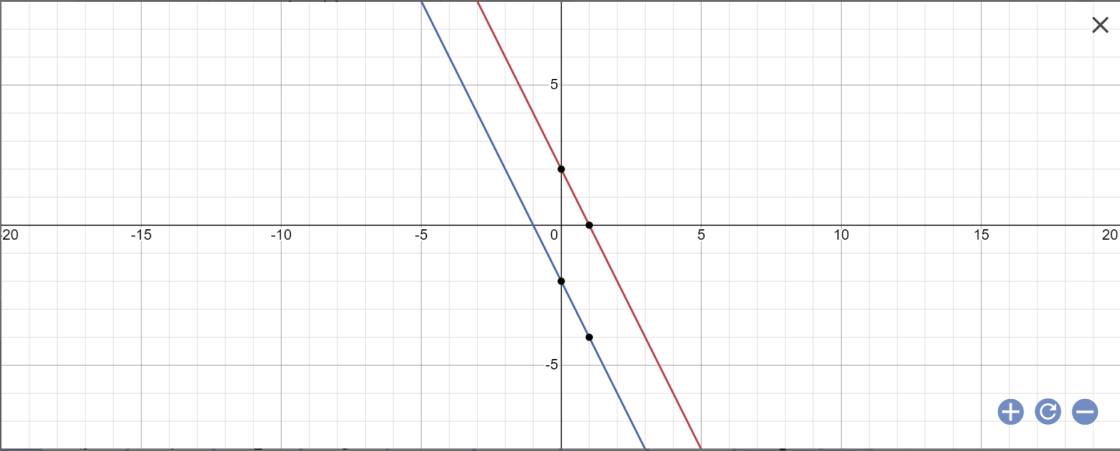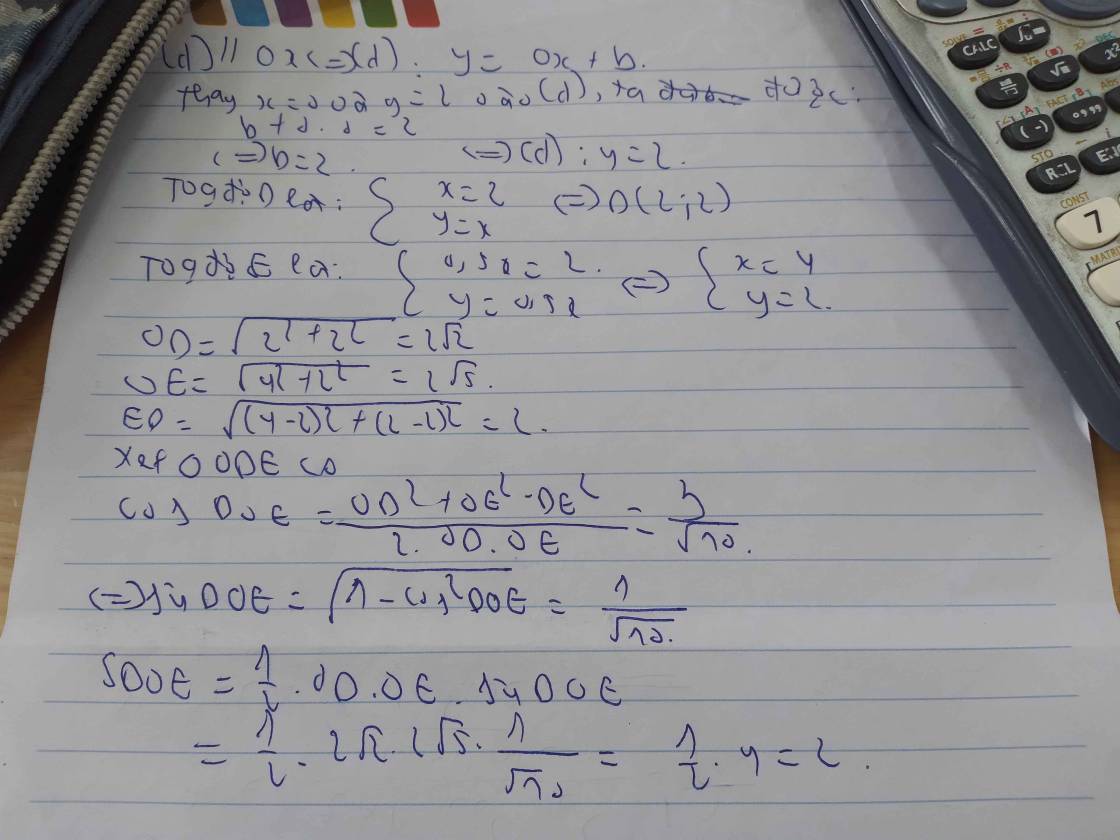Hãy nhập câu hỏi của bạn vào đây, nếu là tài khoản VIP, bạn sẽ được ưu tiên trả lời.

a: Tọa độ A là:
y=0 và -2x+2=0
=>x=1 và y=0
=>A(1;0)
Tọa độ B là:
x=0 và y=-2x+2
=>x=0 và y=-2*0+2=2
=>B(0;2)
b: C thuộc Ox nên C(x;0)
D thuộc Oy nên D(0;y)
ABCD là hình thoi nên AB=AD và vecto AB=vecto DC
A(1;0); B(0;2); C(x;0); D(0;y)
\(\overrightarrow{AB}=\left(-1;2\right);\overrightarrow{DC}=\left(x;-y\right)\)
\(AB=\sqrt{\left(0-1\right)^2+\left(2-0\right)^2}=\sqrt{5}\)
\(AD=\sqrt{\left(0-1\right)^2+\left(y-0\right)^2}=\sqrt{y^2+1}\)
vecto AB=vecto DC
=>x=-1 và -y=2
=>x=-1 và y=-2
AB=AD
=>y^2+1=5
=>y^2=4
=>y=2(loại) hoặc y=-2(nhận)
Vậy: x=-1 và y=-2
=>C(-1;0); D(0;-2)
Gọi phương trình (d2) có dạng là y=ax+b
(d2) đi qua C và D nên ta có hệ phương trình:
a*(-1)+b=0 và 0*a+b=-2
=>b=-2 và -a=-b=2
=>a=-2 và b=-2
=>y=-2x-2
c: (d1): y=-2x+2 và (d2): y=-2x-2


Đường thẳng d cắt trục \(Ox\) tại \(C\left(0;a\right)\) và cắt trục \(Oy\) tại \(D\left(b;0\right)\) \(\left(a;b>0\right)\)
Để \(\Delta OCD\) cân tại \(O\) \(\Rightarrow OC=OD\)
mà \(\left\{{}\begin{matrix}OC=\sqrt[]{a^2}=a\\OD=b^2=b\end{matrix}\right.\left(a;b>0\right)\)
\(\Rightarrow a=b\)
Phương trình đường thẳng d có dạng
\(\dfrac{x}{a}+\dfrac{y}{b}=1\)
\(\Leftrightarrow\dfrac{x}{a}+\dfrac{y}{a}=1\)
\(\Leftrightarrow x+y-a=0\)
mà \(\left(d\right)\) qua điểm \(A\left(1;2\right)\)
\(\Rightarrow1+2-a=0\)
\(\Leftrightarrow a=3\)
Vậy phương trình đường thẳng \(\left(d\right):x+y-3=0\)

\(b,\text{PT giao Ox của }\left(d_2\right):y=0\Leftrightarrow-x+3=0\Leftrightarrow x=3\Leftrightarrow B\left(3;0\right)\Leftrightarrow OB=3\\ \text{PTHĐGĐ }\left(d_1\right)\text{ và }\left(d_2\right):2x=-x+3\Leftrightarrow x=1\Leftrightarrow y=2\Leftrightarrow A\left(1;2\right)\\ \text{Gọi }H\text{ là đường cao từ }A\text{ của }\Delta OAB\\ \Rightarrow AH=\left|y_A\right|=2\\ \Rightarrow S_{OAB}=\dfrac{1}{2}AH\cdot OB=\dfrac{1}{2}\cdot2\cdot3=3\left(đvdt\right)\)

a: Đặt (d1): y=ax+b(a<>0)
Vì (d1) vuông góc với (d) nên 3a=-1
=>\(a=-\dfrac{1}{3}\)
Vậy: (d1): \(y=-\dfrac{1}{3}x+b\)
Tọa độ A là:
\(\left\{{}\begin{matrix}y=0\\-\dfrac{1}{3}x+b=0\end{matrix}\right.\Leftrightarrow\left\{{}\begin{matrix}y=0\\-\dfrac{1}{3}x=-b\end{matrix}\right.\)
=>\(\left\{{}\begin{matrix}y=0\\\dfrac{x}{3}=b\end{matrix}\right.\Leftrightarrow\left\{{}\begin{matrix}x=3b\\y=0\end{matrix}\right.\)
=>A(3b;0)
Tọa độ B là:
\(\left\{{}\begin{matrix}x=0\\y=-\dfrac{1}{3}\cdot0+b=b\end{matrix}\right.\)
=>B(0;b)
\(AB=2\sqrt{10}\)
=>\(AB^2=40\)
=>\(\left(0-3b\right)^2+\left(b-0\right)^2=40\)
=>\(10b^2=40\)
=>\(b^2=4\)
=>b=2 hoặc b=-2
Vậy: (d1): y=-1/3x+2 hoặc (d1): y=-1/3x-2
b: Đặt (d2): y=ax+b
Vì (d2)//(d) nên \(\left\{{}\begin{matrix}a=3\\b\ne-5\end{matrix}\right.\)
Vậy: (d2): y=3x+b
Tọa độ C là:
\(\left\{{}\begin{matrix}y=0\\3x+b=0\end{matrix}\right.\Leftrightarrow\left\{{}\begin{matrix}y=0\\x=-\dfrac{b}{3}\end{matrix}\right.\)
=>\(C\left(-\dfrac{b}{3};0\right)\)
tọa độ D là:
\(\left\{{}\begin{matrix}x=0\\y=3x+b=3\cdot0+b=b\end{matrix}\right.\)
=>D(0;b)
\(OC=\sqrt{\left(-\dfrac{b}{3}-0\right)^2+\left(0-0\right)^2}=\sqrt{\left(\dfrac{b}{3}\right)^2+0}=\dfrac{\left|b\right|}{3}\)
\(OD=\sqrt{\left(0-0\right)^2+\left(b-0\right)^2}=\sqrt{0^2+b^2}=\left|b\right|\)
Vì Ox\(\perp\)Oy nên OC\(\perp\)OD
=>ΔOCD vuông tại O
=>\(S_{OCD}=\dfrac{1}{2}\cdot OC\cdot OD\)
=>\(S_{OCD}=\dfrac{\dfrac{1}{2}\left|b\right|}{3}\cdot\left|b\right|=\dfrac{1}{2}\cdot\dfrac{b^2}{3}\)
Để \(S_{OCD}=6\) thì \(\dfrac{b^2}{6}=6\)
=>\(b^2=36\)
=>\(b=\pm6\)
Vậy: (d2): y=3x+6 hoặc (d2): y=3x-6
Để ΔOCD cân tại O thì OC=OD
=>\(\dfrac{\left|b\right|}{3}=\left|b\right|\)
=>\(\left|b\right|=0\)
=>b=0
Vậy: (d2): y=3x